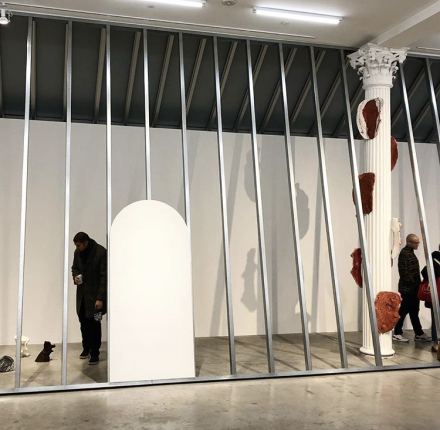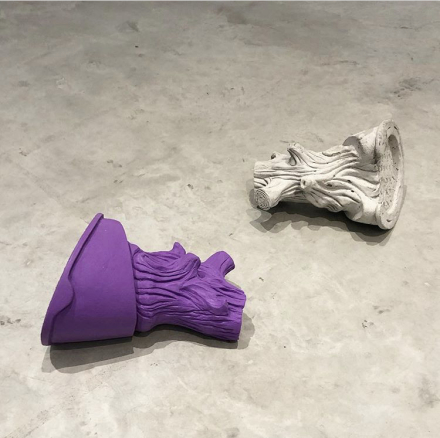
Lena Henke, Germanic Artifacts (Installation View), via Art Observed
Currently on view at Bortolami Gallery this winter, artist Lena Henke has opened her first solo exhibition with the space, delving back into her ongoing exploration of diverse historical convergences, cultural forms and the history of sculpture as both aesthetic field and technical necessity.
Henke’s installation at the gallery is, at its core, a subtle and simultaneous inversion and reflection of early architectural structures of the Germanic tribes that lived among the marshes and thickets of the German landscape around 300 BC. These long, narrow structures were built to enclose fires, bringing heat indoors and forming a domestic womb. Henke embraces fire—which bakes clay, forges metal, and melts sand into glass—as a symbol of life and transformation. Her works in the show echo this, from re-creations of Germanic hovels, to small sculptural interpretations of horse hooves (complete with shoes attached).

Lena Henke, Germanic Artifacts (Installation View), via Art Observed

Lena Henke, Germanic Artifacts (Installation View), via Art Observed
Henke spotlights individual sculptures and filters the winter sun through a row of metal studs. Outfitted with two solid “doorways,” the cage-wall creates a transitory space that recalls the multifunctional abodes Die Germanen built. The structure tilts at an angle echoing the architecture of the skylight, casting subtle shadows on the gallery’s columns and Henke’s sculptures, as if sunlight were moving through a forest canopy. Visitors can pass between the studs to enter the demarcated space, inverting the outside/inside relationship—an apt metaphor for Henke’s ongoing exploration of transformative states, material processes, and history. In the belly of the gallery there is an over-sized Germanic boar with stout legs, meticulously sculpted by Henke and dyed purple, yet boasting strange hunks hewed out of its side, as if the primitive creation of the object emphasized its origins as an icon of the UR Mutter (mother of origin) in Germanic myth. A second boar is cast nearby in chainmail, adding an understanding of the evolution of technology and weaponry through fire itself.

Lena Henke, Germanic Artifacts (Installation View), via Art Observed

Lena Henke, Germanic Artifacts (Installation View), via Art Observed
Perhaps this note makes for one of the more intriguing points of the show, one which finds a particularly resonant underpinning in the neon light installation placed outside the gallery. Posing her own name in Futhark, the oldest form of runic characters, Henke both subverts nationalistic/racial associations, and twists vastly divergent threads of technological and social “making” through a single object. Her works here concern themselves with evolution and growth, the origins of the technological reinterpretation of society, and the changing cultural forms that spring from it. Presented within the gallery as a dense network of images tracing the roots of social development through technics, Henke’s pieces explore the human progression in connection with, posed against, and in observation of, the natural world.
Her work is on view through February 16th.
— D. Creahan
Read more:
Lena Henke: Germanic Artifacts [Exhibition Site]



